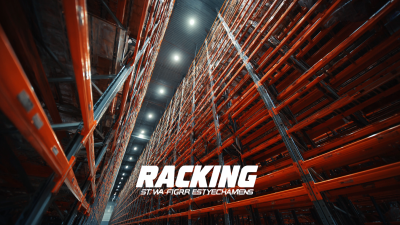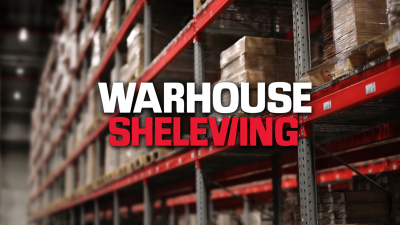What is a Warehouse Pallet Racking System and How Does It Optimize Storage Efficiency?
In today's fast-paced supply chain landscape, optimizing storage efficiency is crucial for businesses looking to enhance their operational effectiveness. A Warehouse Pallet Racking System plays a pivotal role in meeting these needs by maximizing the use of vertical space and improving inventory accessibility. According to the 2022 Warehousing and Fulfillment report by the Material Handling Industry of America, the implementation of advanced racking systems can increase storage capacity by up to 40%, resulting in significant reductions in operational costs. Furthermore, strategically designed pallet racking can reduce picking time by 50%, enabling faster order fulfillment and better customer satisfaction. As logistics demands continue to evolve, understanding and effectively utilizing a Warehouse Pallet Racking System becomes essential for companies aiming to improve their warehouse efficiency and maintain a competitive edge in the market.

Understanding Warehouse Pallet Racking Systems: Key Components Explained
 Warehouse pallet racking systems are essential for optimizing storage efficiency within warehouse spaces. At the core of these systems are several key components that work together to maximize capacity and organization. First, upright frames provide the structural foundation, allowing vertical stacking of pallets while ensuring stability. Crossbeams connect these frames and support the pallets, making it easy to customize the height and arrangement according to the specific needs of the stored goods.
Warehouse pallet racking systems are essential for optimizing storage efficiency within warehouse spaces. At the core of these systems are several key components that work together to maximize capacity and organization. First, upright frames provide the structural foundation, allowing vertical stacking of pallets while ensuring stability. Crossbeams connect these frames and support the pallets, making it easy to customize the height and arrangement according to the specific needs of the stored goods.
In addition to uprights and crossbeams, accessories like pallet supports and safety bars enhance the functionality and safety of the racking system. Pallet supports help minimize the risk of pallet collapse, ensuring that goods remain securely stored. Furthermore, safety bars and mesh decks prevent items from falling, adding an extra layer of protection. By incorporating these components effectively, warehouse managers can create an adaptable storage environment that meets changing inventory demands, ultimately driving efficiency and cost-effectiveness within operations.
Types of Pallet Racking Systems: Choosing the Right Solution for Your Needs
When it comes to maximizing storage efficiency in warehouses, understanding the different types of pallet racking systems is essential. There are several designs available, each catering to specific operational needs. The most common types include selective racking, drive-in racking, and FIFO (first-in, first-out) systems. According to a report by MarketsandMarkets, the global warehouse storage and shelving market is projected to grow significantly, reaching $20.36 billion by 2025, driven largely by increasing demand for efficient inventory management solutions.
Selective racking is ideal for businesses that require easy access to each pallet. This system allows for direct access to all inventory items and is flexible in terms of layout, accommodating various pallet sizes. Drive-in racking maximizes storage density by allowing forklifts to enter the racking system, making it perfect for high-volume storage with low SKU counts. On the other hand, FIFO systems are designed for perishable goods, ensuring that older inventory is used first, which can lead to reduced waste and improved product rotation. The choice of racking system depends on factors such as warehouse layout, inventory turnover rates, and specific operational needs, highlighting the importance of tailored solutions in achieving optimal storage efficiency.
Warehouse Pallet Racking Systems: Types and Storage Capacity
This chart illustrates the storage capacity differences between various types of pallet racking systems commonly used in warehouses. Understanding these capacities can help optimize storage efficiency.
Benefits of Pallet Racking: Enhancing Space Utilization and Accessibility
Pallet racking systems play a crucial role in optimizing storage space within warehouses. By utilizing vertical space, these systems allow businesses to increase their storage capacity significantly without expanding the physical footprint of the facility. This vertical arrangement enables a higher density of goods, which can lead to more efficient inventory management and reduced operational costs. Furthermore, different designs such as selective, drive-in, and push-back racking cater to various warehousing needs, thereby enhancing overall space utilization.
In addition to maximizing space, pallet racking systems improve accessibility to stored items. With organized rows of pallets, employees can quickly identify and retrieve products, minimizing the time spent searching for inventory. This streamlined access not only accelerates order fulfillment but also reduces the risk of damage to goods during handling. By ensuring that items are easily reachable, pallet racking enhances workflow efficiency, ultimately contributing to improved productivity and customer satisfaction within warehouse operations.
Optimizing Warehouse Layout: Best Practices for Pallet Racking Installation
Optimizing a warehouse layout is crucial for maximizing storage efficiency, and the installation of a pallet racking system plays a significant role in this process. Proper planning and configuration of pallet racks can help create an organized and accessible storage environment, reducing the time and effort needed to retrieve goods. When designing the layout, factors such as product size, inventory turnover rates, and picking methods should be taken into account to ensure that the system meets operational needs effectively.
In the context of modern warehousing, innovative solutions like standardized unit load carriers have emerged as essential components for efficiency. For instance, using modular racking systems can enhance flexibility, allowing warehouses to adapt their storage as inventory changes. Furthermore, implementing technology-driven tools for inventory management within the racking system ensures accurate tracking of stock levels, ultimately optimizing space utilization. The synergy between strategic racking and advanced logistics solutions enables warehouses to operate at peak efficiency, leading to improved productivity and customer satisfaction.
Warehouse Pallet Racking System Overview
| Dimension | Specification | Benefit |
|---|---|---|
| Height | Up to 30 ft (9 m) | Maximize vertical space usage |
| Load Capacity | Over 2,000 lbs per shelf | Support heavy products |
| Pallet Size | 48 x 40 inches (standard) | Standardization of storage |
| Accessibility | Selective and drive-in options | Improved picking efficiency |
| Configuration | Single-deep, double-deep, and multi-tier | Customizable to warehouse needs |
| Material | Steel | Durability and strength |
| Safety Features | Safety locks, guards | Enhanced worker safety |
Maintaining Safety and Compliance in Your Pallet Racking Setup
 Maintaining safety and compliance in a pallet racking setup is crucial for ensuring both the well-being of warehouse personnel and the efficiency of operations. According to the Occupational Safety and Health Administration (OSHA), proper pallet racking systems can minimize workspace hazards, potentially reducing workplace injuries by over 50%. Regular inspections and adherence to load capacities specified by manufacturers can prevent incidents that pose significant risks to employees and inventory.
Maintaining safety and compliance in a pallet racking setup is crucial for ensuring both the well-being of warehouse personnel and the efficiency of operations. According to the Occupational Safety and Health Administration (OSHA), proper pallet racking systems can minimize workspace hazards, potentially reducing workplace injuries by over 50%. Regular inspections and adherence to load capacities specified by manufacturers can prevent incidents that pose significant risks to employees and inventory.
Tips: Implement a routine inspection schedule for your pallet racking system, focusing on signs of wear, potential damage, or overloading. Utilize signage that clearly communicates load limitations and safe operating procedures to all employees. Consider training sessions that outline best practices for safe material handling and racking use, helping to cultivate a culture of safety.
Another crucial aspect of safety and compliance is the integration of local building codes and industry standards into your racking system design. The Rack Manufacturers Institute (RMI) recommends adhering to guidelines such as the ANSI/RMI MH16.1 standard to ensure your setup meets recognized safety benchmarks. By prioritizing compliance, you not only protect your workforce but also enhance operational efficiency, fostering an environment where productivity thrives without compromising safety.
Related Posts
-

The Future of Best Pallet Racking Systems: Innovations Shaping Warehouse Efficiency
-

How to Choose Best Pallet Shelving Solutions for Future Technology Trends in 2025
-

Unlocking Efficiency with the Best Warehouse Pallet Racking System Benefits for Global Buyers
-

Future Warehouse Racking Trends in 2025 and Its Advantages for Global Buyers
-

Elevating Global Supply Chains with Premium Storage Racking Solutions from China
-

8 Essential Benefits of the Top 5 Best Warehouse Shelving Systems for Global Buyers

